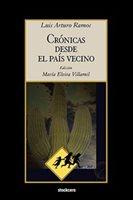Cronicas desde el Pais vecino" (Chronicles from the country next door) is a collection of short chronicles published in Mexican newspapers in the late 1990s by Luis Arturo Ramos. The essays all illustrate the viewpoint of a Mexican citizen as he perceives everyday life in the United States. Most of them reflect the past or present history of the U.S. As 1990s commentary, it deals explicitly with frontier issues, and with neo-liberal policies that affect both Mexico and the United States as the 21st century begins. In these nine brief texts Ramos discusses many subjects and comments upon different places and events. The "boundary" quality of these pieces is evident as numerous trips along the frontier are described, and in the choice of the chronicle as genre. The author travels along the border at El Paso and Juarez, la Mesilla, Las Cruces, Oklahoma and Wichita. He also bears witness to Cuauhtemoc Cardenas visit to El Paso, and to Mexican writer Carlos Fuentes' speech at the Univ. of Colorado in Boulder. He observes the protest march at the Univ. of Texas in El Paso, on the occasion of the 500th anniversary of Columbus' arrival in the New World. He joins actor Anthony Quinn on his visit to El Paso, and uses the occasion to discuss identity issues. He travels as a tourist as he thinks about Pancho Villa's attack on Columbus, New Mexico, and he visits Victoriano Huerta's grave at the "Evergreen" cemetery in El Paso. He writes about the appearance of the "chupacabras" (goat-sucker), and its significance within collective imagination. Finally, in the chronicle that close the collection, Ramos visits both the Holocaust and the Border Patrol Museums in El Paso, and criticizes their dehumanizing vision of the Latin American immigrant. "Cronicas desde el Pais vecino" provides an outstanding entry point for further investigation, deepening perspectives and provoking discussion about several socio-political aspects of the border zone. At the same time the reader will enjoy the author's subtlety and wit. This sharply perceptive humor and the format it is given, due to its linguistic dexterity, allows the reader to visualize scenes from daily life, as well as the architecture and geomorphology of the American Southwest. This edition by Prof. Maria Elvira Villamil includes analysis of the texts as well as information about the author and his writings within a socio-political context. The introduction analyzes various perspectives on the chronicle as literaty genre, and its relationship to other literature. Topics relevant to the text are discussed, as is its regional historical framework both as seen by Luis Arturo Ramos and by scholars in other disciplines.
-
- Categories
- Architecture
- Art
- Cars & Motorcycles
- Design
- DIY & Crafts
- Education
- Film, Music & Books
- Fitness
- Food & Drink
- Gardening
- Geek
- Hair & Beauty
- History
- Holidays & Events
- Home Decor
- Humor
- Kids
- Women's Fashion
- Men's Fashion
- Leisure & Outdoors
- People
- Photography
- Products
- Science & Nature
- Sports
- Technology
- Travel & Places
- Weddings
- Other
- Property
- Animal
- Celebrities
- Health & Fitness
- Illustrations & Posters
- Quotes
- Services
- Renovation
- Home Building
- Business
- Toys
- New
- Popular
- Gifts
- Videos
- Help / Contact Us
- Terms & Privacy
- What is InterestPin


